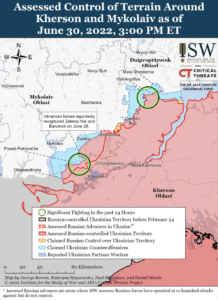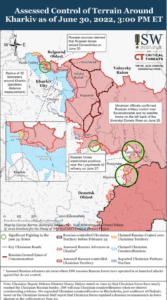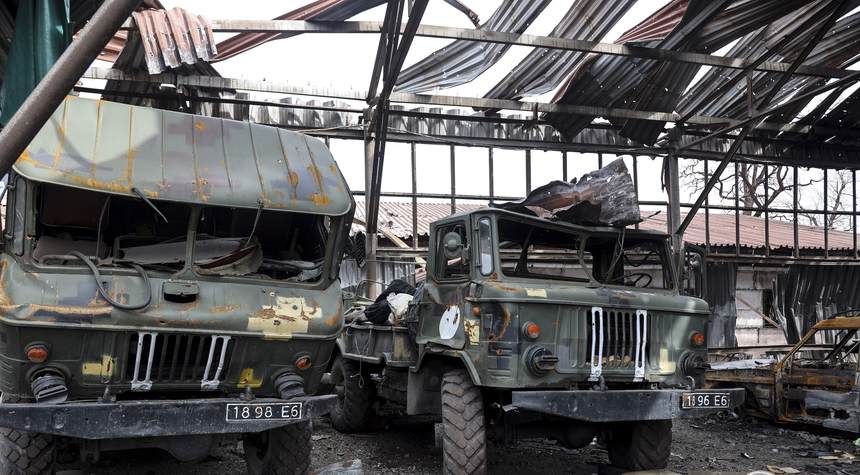Let’s look at the situation 128 days after Vladimir Putin’s 72-hour Special Military Operation Against Ukraine.
Strategic Level
Major Takeaways from the NATO Summit
NATO member states have agreed to supply offensive weapons to Ukraine. NATO had previously agreed to send HIMARS/MLRS into Ukraine. They agreed to supply them with rockets that would not directly threaten the Russian population. They will be far superior to the T-62s which began appearing in Russian units as replacement tankers.
NATO/EU is trying to establish transit routes to Ukraine to transport grain via Poland to bypass Russia’s Black Sea Blockade.
The big news is that Sweden, Finland, and NATO will be joining. There is the possibility that the Bulgarian government could object, as it gets 70% of its natural resources from Russia. This would make it a risky decision to join NATO.
Joe Biden, France’s Macron, and Germany’s Scholz all stated that: 1) The war will be long; 2) Russia must not win territory from it, and 3) They will do whatever it takes to make sure Ukraine is able to defend its territory from invading Russians. Talking is one thing, convincing economically-challenged voters is another.
The idea of forcing Ukraine to sign a disabling agreement with the Russian government is now the domain of those who believe that Russia is the aggrieved party that must be mended.
Words and deeds both indicate that Russia is in trouble, and can be defeated.
Russia’s government, which doesn’t include Russian Duma/Federal Assembly members who can speak at least twice as crazily as Maxine Waters, has reacted to the threat of nuclear Armageddon. Putin threatened Belarus with nuclear-capable missiles. This is a weapon Russia had to give up when the INF treaty was signed.
Operational Level
It’s always good to keep track of the situation on the ground. This video shows the war’s first 90 days.
This map was created by the Institute for the Study of War. It shows the frontline as it exists today. We’ll soon be attacking the Russian operation in Donbas, but there are not many major changes.

Action with new tools
The US approved Harpoon missiles being transferred from trucks to Ukraine. They were responsible for sinking Vasily Bekh, a seagoing tug.
Better video, clearly shows the Russian tug being hit by two Ukrainian antiship cruise missiles https://t.co/spvmBlfFzK pic.twitter.com/wJni7UsgNy
— OSINTtechnical (@Osinttechnical) June 17, 2022
HIMARS makes its debut.
Clear difference betweeen MLRS Grad/Uaragan and American HIMARS pic.twitter.com/IvQRaDevNj
— Giorgi Revishvili (@revishvilig) June 24, 2022
Ukraine will get a substantial infusion of NATO top-of-the-line tube and rocket artillery. Due to millions of dollars flowing into war, it is possible that foreign civil contractors may be performing higher echelon maintenance.
Many hundreds of Ukrainians have been trained in the use and maintenance of new artillery in Germany, the UK, and other countries. They are continuing to train more.
The first Mariupol prisoner exchange has been completed
After the fall of Mariupol, around 1,700 Ukrainian soldiers were taken into Russian control. They are currently in Ukraine, according to the negotiated surrender agreement.
144 Ukrainian POWs returned today in a prisoner exchange with Russia. https://t.co/t3PJIQYm22 pic.twitter.com/HIIJBWwPfW
— OSINTtechnical (@Osinttechnical) June 29, 2022
Terrorism has become a weapon.
A Russian cruise missile rammed a Kremenchuk shopping center last week.
Kremenchuk.
Missile strike by Russian missiles on the shopping center.
Zelensky: It is impossible to imagine the number of victims.If this is not a terrorist attack, then what!? If Russia is not a terrorist country, then who are they? pic.twitter.com/jWhQdtSkSB
— Roman Hryshchuk (@grishchukroma) June 27, 2022
This is the moment a Russian missile struck a shopping mall in Kremenchuk, Ukraine, on Monday. Ukrainian security services released the footage from various angles of the property, where at least 20 people were killed during the strike. https://t.co/SYcWWersoa pic.twitter.com/ViGPLNuXTW
— CBS News (@CBSNews) June 30, 2022
As of 10:00, the death toll of the Russian missile attack on Odesa’s Serhiivka was 18, 38 civilians were injured and hospitalized, 8 people were rescued from the rubble by Emergency Service workers.https://t.co/Rk4bg6wBKDhttps://t.co/gbjaYHAD2g pic.twitter.com/hHFdtebTFD
— Euromaidan Press (@EuromaidanPress) July 1, 2022
This isn’t an isolated incident. Russian rockets are striking civilian targets multiple times per week. It seems that terror has become a common tactic for Russia.
Russian generals are still being fired.
Chaos continues in Ukraine’s Russian chain of command.
Putin fired five Russian generals from the military’s top brass this week amid Moscow’s stumbling invasion of #Ukraine. https://t.co/UWaiCiJDak
— Viktor Kovalenko (@MrKovalenko) June 4, 2022
It is hard to comprehend what is going on without knowing the context. Situations? Is it the politically connected, incompetent generals being eliminated?
HIMARS is a new army that has unique organizational features. It allows the Ukrainians to target headquarters far from the reach of tube artillery.
Ukrainian prisoners sentenced to death by a Donetsk Court
As many as 30.000 foreign volunteers are serving in Ukraine’s Territorial Defence Forces.
The two British volunteers (Sean Pinner and Aiden Aslin) and the Moroccan (Saadoun Brahim) captured in eastern #Ukraine have been sentenced to death by #Russia‘s puppet republic in Donetsk, according to Russian media. https://t.co/QATVYSKwMO
— Kyle Orton (@KyleWOrton) June 9, 2022
Two Americans were taken prisoner and are likely to share the same fate.
The Kremlin has suggested that the two men could face execution.https://t.co/CWAvLzKRyy
— Radio Free Europe/Radio Liberty (@RFERL) June 21, 2022
Snake Island
Snake Island was made uninhabitable with modern artillery and Harpoon Antiship Missiles. The same goal could be achieved by shooting at civilian ships.
The russian ministry of defence explained the withdrawal of troops from the Snake Island as a ‘good will gesture’.
Ladies and gentlemen, this is how a good will gesture looks like: pic.twitter.com/uRxqrGAciZ
— Anton Shvets (@ShvetsAntonAnd) June 30, 2022
I have already mentioned that the Russian anti-ship missiles fired at Snake Island pose a threat to Russia’s remaining Black Sea frontage. This includes Odesa and Danube estuaries.
Kherson
There has been significant activity on the southern front. These maps were provided by the Institute for the Study of War.

Kherson City is located six miles away from the Ukrainians.
Kharkiv
Kharkiv is essentially static. Ukraine’s primary goal is to drive Russian artillery out of Kharkiv’s range and expel forces that could have been used to defend Donetsk under an economy-of-force operation.

According to my prediction, this will probably remain a backwater.
Donetsk
The Russians have had some success in this theater, so it has been the most coveted media story.
Following a string of high-profile disasters, the Russians seem to have switched to mounted operations, which are supported by large artillery fires. General Mick Ryan from Australia believes that his view is the correct one.
Sometimes, the Ukrainians will have to temporarily give up territory to win this war. While losing territory is bad for a country at war; losing your army is fatal. The Ukrainians have had a tough week. But it is not the same as them losing the war. https://t.co/hdErZbs2rp
— Mick Ryan, AM (@WarintheFuture) June 30, 2022
Both sides have suffered heavy casualties. However, the Ukrainians lack the combat power to stop the Russian advance. The Russians do not have the troops or the logistics system to stop the Russian advance.
Prognosis
At the moment, the war is deadlocked. I haven’t seen much in the underlying dynamics. Making daily combat operations predictions is like political analysts making new forecasts based on each poll.
The true struggle is hidden. These reports are based on intercepted phone calls and seem to be based on Russian veterans being offered three-month contracts to support Ukraine.
I believe that Ukrainian equipment has been replaced with more modern versions. These will be crucial in a long war.
No evidence suggests that Ukraine is in danger of political or moral collapse.
I think Russia is looking for an exit. This could lead to political problems in NATO/EU if Ukraine keeps the war going.
I think this will continue through August, and then we’ll see new rounds with other armies.


